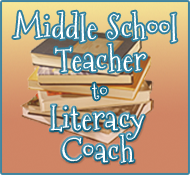OBSERVE...THINK...QUESTION
I'm going to share one of my all-time favorite inquiry-based teaching strategies today. I loved it so much in fact, that I incorporated prompts for it permanently in my classroom. The strategy is called Observe, Think, Question. If you would have walked into my classroom you would have quickly seen a large Eye (observe), a Brain (think), and a questions mark (questions) hanging from the ceiling.
This strategy can be used in any content area using only a photograph, text, or even a video clip. It very simple, and once your students learn it, they can participate pretty seamlessly at any point in your day, in any subject area.
FIRST: the teacher displays an artifact, text, photograph or video clip and the students write (either on a pre-made graphic organizer or a notebook page they have chosen) about what they notice. It takes some practice, but they get good at just "stating the obvious." This stage of the strategy anchors them in the reality without letting them jump ahead to application or prediction. For example, if I displayed this book cover to my students
They might write observations like:
* I see that it is a boy
* I notice he has only one eye
* I notice that there is no nose or mouth
NEXT: The students can verbally share, or record on their paper thoughts they have, and predictions. For the above book cover they may say:
* I think this boy must be the main character
* I think his eye is important
* I think he might wonder a lot because of the title Wonder
LASTLY: Students ask questions about the artifact, text, photo or video clip. I usually have them record their questions first and then pair up to share and generate a few more.
By the end of the exercise, you can imagine that a lot of interest, background knowledge and predicting has been done. It is a helpful strategy that I found replaced KWL charts in my classroom very quickly. Revisiting the OTQ work after learning has occurred allows for reflection as well. Think about how you might do this....
display a map with no title or legend in geography....
show a video clip like this without sound in your biology class....
Try it out and let us know what you think!
Blogs to Visit


Monitoring Comprehension
From Cris Tovani's Book I Read It, But I Don't Get It
Content Area Literacy
"Adolescents entering the adult world in the 21st century will read and write more than at any other time in human history. They will need advanced levels of literacy to perform their jobs, run their households, act as citizens, and conduct their personal lives."-- Richard Vaca, author of Content Area Reading: Literacy and Learning Across the Curriculum
Close Reading
"The primary objective of close reading is to afford students with the opportunity to assimilate new textual knowledge and prior experiences to expand their schema....activation alone, although important, doesn't expand knowledge. The secondary purpose of a close reading is to build the necessary habits of readers when they engage with a complex piece of text."
(Fisher & Frey, 2012)
(Fisher & Frey, 2012)
To read more from Fisher & Frey, visit www.reading.org and search for the November 2012 issue of The Reading Teacher
Although much of what you read about the procedures for close reading will tell you the first read should be a "cold" read, Catherine Snow explains in this recent article, the importance of "warming students up" to the text they are about to close read. "If students find the tasks we give them to be too difficult or too irrelevant to bother with, then the rigor will be of little value."
| Click HERE to read Catherine Snow's article |
 |
Here are examples of how this can be done in a content areas:







No comments:
Post a Comment